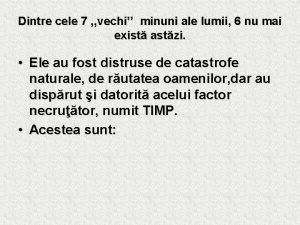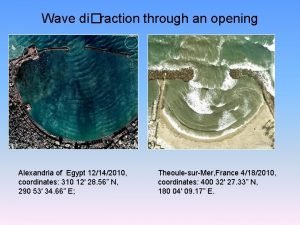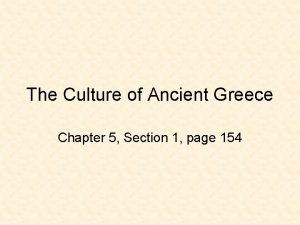Pharos at Alexandria Pharos is actually the name





















- Slides: 21

Pharos at Alexandria

• Pharos is actually the name of the island on which it was built but over time, the two became inextricably linked, so that the word pharos became the word for lighthouse and still is in French and Italian. Sort of like Q-tip and ear-swab • Built in 290 BCE • 1 st lighthouse in the world. • Tallest building in the world, besides the pyramids. • Not at all like a modern lighthouse, but more like a modern day skyscraper • Light was shone using mirrors and fire. • After completion, the architect requested his name be placed on it. The ruler said no. So the architect chiseled his name in anyway, but plastered over it. He then chiseled the ruler’s name on top of the plaster.


Colossus of Rhodes

• • Destroyed by Earthquake Located in Rhodes (Greece) Built in the likeness of Helios Never rebuilt it after the earthquake, because they assumed Helios did not approve of the statue. • Built to celebrate the victory over a successor fo Alexander the Great, somewhere in the 300’s BC

Statue of Zeus: “…was moved to his soul, as if he had beheld the god in person. ”

Zeus state picture 2

Chryselaphantine: meaning made of ivory and gold Made around the 430 s BC Took 12 years to make Nike (goddess of victory) sits in his hand

Hanging Gardens of Babylon

Hanging Gardens Picture 2

Hanging Gardens Picture 3

Temple of Artemis

". . . but when I saw the house of Artemis that mounted to the clouds, those other marvels lost their brilliancy, and I said, 'Lo, apart from Olympus, the Sun never looked on aught (anything) so grand. " - Antipater of Sidon • Temple of Artemis in Ephesus. • First built around 800 B. C. on a marsh and contained a meteorite (Greeks thought this meteorite was sent from Jupiter) • Pliny reported that it took 120 years to build • Destroyed first by King Croesus of the Lydians but he then rebuilt it to gain favor. • After rebuilding, destroyed again by an arsonist, wanting to be immortalized. So the government destroyed all records of his name. Some claim his name to be Herostraus. • Legend was that Alexander the Great was born on the day of this arson. • Nothing remains of the 300 ft long and 150 ft wide temple today except a single column and the foundation.

Statue of Artemis from the temple. Bull testicles or eggs

In Ephesus, Artemis regarded as Fertility Goddess not as Goddess of the Hunt. She also could have been Cybele / Artemis

Pyramid of Giza: Originally, the structure being made of limestone would shine every time the sun hits it.

The Great Pyramid is composed of over 2 ½ million blocks of limestone which weigh from 2 to 70 tons each. Its base covers over 13 acres and its volume is around 90, 000 cubic feet. Most likely built around 2600 BC Built to honor Khufu, the pharoh who died. Scholars today could not build this kind of structure

Mausoleum of Mausolus

mausoleum: a stately and magnificent tomb OR a burial place for the bodies or remains of many individuals, often of a single family Hence, we get the word mausoleum from this monument.

Built by the same architect of the Temple of Artemis and built in honor of king Mausolus in 353 BCE Mausolus was a Persian Satrap of Halicarnassus. Satrap means local governor for the Persians ruling a non-Persian territory. Mausolus highly regarded, because he spoke Greek and embraced Greek customs. Built by sister/wife, Artemisia, in her grief wanting to spare no expense to honor him. Died 2 years after him. Survived until 1400’s AD despite some damages caused by earthquakes. Ultimately, destroyed by Crusaders using it as raw materials to build forts. Nothing left except foundation.

frieze from the Mausoleum how it would have appeared in ancient times below
 Pharos tulane
Pharos tulane Alexandria magnum portum habet
Alexandria magnum portum habet Pope dioscorus i of alexandria
Pope dioscorus i of alexandria Alexandria goins
Alexandria goins Alexandria digital library
Alexandria digital library Alexandria digital library
Alexandria digital library Clement of alexandria paedagogus
Clement of alexandria paedagogus Apa serv alexandria
Apa serv alexandria The ancient library of alexandria
The ancient library of alexandria Heron von alexandria geboren
Heron von alexandria geboren Farul din alexandria aflat pe o insulă mică numită
Farul din alexandria aflat pe o insulă mică numită Mausoleum von halikarnassos zerstörung
Mausoleum von halikarnassos zerstörung Pope demetrius i of alexandria
Pope demetrius i of alexandria Marti reinfeld
Marti reinfeld Alexandria kos
Alexandria kos Coordinates of alexandria egypt
Coordinates of alexandria egypt Alexandria city public schools
Alexandria city public schools Alexandria brewed espresso steamed milk
Alexandria brewed espresso steamed milk Alexandria vattimo
Alexandria vattimo Why did the city of alexandria attract scholars
Why did the city of alexandria attract scholars Alexandria phan md
Alexandria phan md Name a line containing point a
Name a line containing point a









































